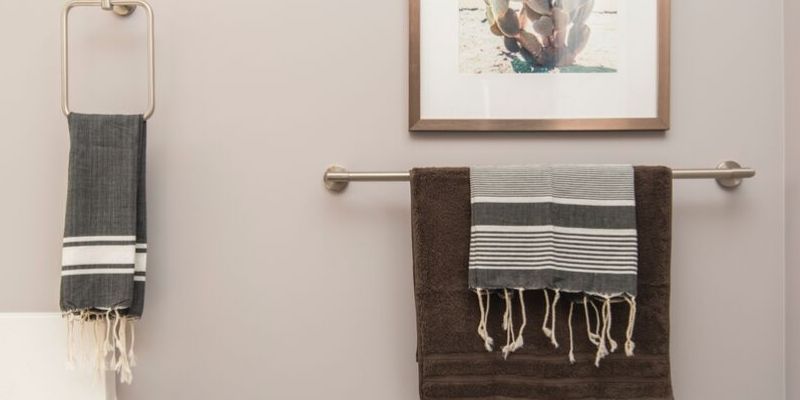Your ultimate guide to decorators paint brushes

So the faithful paint brush has been in every decorators and home DIY enthusiasts toolbox for many years, ever since it was invented in 300BC. However, what seems like such a simple tool is actually a highly refined tool that has evolved over many years and is now available in a wide variety of sizes and shapes.
Sections in this article
- Handle shapes
- Bristle materials
- Brush stiffness
- Paint brush shapes
- Paint brush types
- How much do paint brushes cost
- Paint brush sizes
Let's start by looking at the different parts of the brush. Every brush is made up of 3 key parts, the handle, the ferrule and the bristles. Each part has its own function and characteristics.
Handle - Usually made from wood, handles come in different shapes and sizes depending on the type of brush. This is where the brush is held.
Ferrule - This part retains the bristles and attaches the bristles to the handle. High quality brushes have ferrules made from Stainless Steel to prevent rusting.
Bristles - These transfer the paint to the surface and are made from different material depending on the type of brush. We'll look into this later in the article.

Diagram showing brush parts
Handle Shapes
Modern trade painters brushes come in a variety of handle shapes and lengths. Many professional decorators will have a personal preference when it comes to handle shape and length but there are specific reasons for each handle style. Some manufacturers have their name for handle styles such as the Sprig or Monarch from Purdy.
However, the most common handle styles are;
Beavertail - Thick and round for fitting nicely into the palm
Fluted - Square with cut-off corners to rest easier in the hand
Rattail - Long and skinny so it can be held like a pencil.
Handle lengths do differ between manufacturers but the overall shape is usually very similar.

So which handle style do you need? Well this is very much personal preference generally. A beavertail handle is good for general painting of walls because it fits nicely into the palm making it comfortable for longer strokes. A rattail handle is typically fitted to trim brushes making it more suited to applications where precision is needed such as painting window frames and door frames. These brushes can be held more like a pencil which gives excellent control. A fluted handle is great from trim work, the long handle rests nicely in the space between your thumb and index finger giving excellent control making them ideal for painting furniture and cutting in.
Bristle Materials
So now we're clear on the different handle shapes it's time to look at what is probably the most important part of the brush, the bristles. Older paint brushes, know as pure bristle brushes were originally fitted with bristles made from animal hair such as OX hair or hog hair. These bristles were great for thick oil-based paints but did require 'breaking in' to provide the best finish. This essentially means knocking off the sharp, misshaped edges of the bristles to be left with a soft brush that provides excellent control. Many professionals would give a new brush to an apprentice to use in the first instance to break the brush in, then once the brush had a bit of wear they would take it back.
Although pure bristle brushes are still available, due to changes in paint and technology most decorators and paint brush brands are moving to synthetic bristles. These have many benefits including being easier to clean, they require less breaking in and are suitable for use in all types of paints, a pure bristle brush is suited to thick oil-based paints which are becoming less common as paint manufacturers look to move to water-based paints. This helps to remove VOC's from the paints, improves drying times, and makes cleaning tools easier.
Are natural bristle brushes a thing of the past?
How to clean and store paint brushes
Synthetic bristles are typically made from nylon, polyester, or a nylon and polyester mix. High-quality brushes are normally fitted with a nylon and polyester blend, this gives the brush good paint load, strength and produces an excellent finish. Synthetic bristle brushes are easier to clean and are resistant to solvents such as white spirit. Thanks to the material paint brush manufacturers can 'flag' the ends of the bristles. This is a manufacturing process that opens the filament of the bristle to allow it to absorb and hold more paint.

Synthetic paint brush bristles close up
Brush Stiffness
When buying a paint brush it is important to consider the stiffness of the brush. This is sometimes controlled by the length of the bristles and also by the material. A stiffer brush like the Purdy Pro-Extra gives excellent control and create a nice crisp line when cutting in, they also work better with thicker paints and are more suited to painting around door frames and trims. A softer brush like the Wooster Silver Tip on the other hand will give a smooth finish with fewer brush strokes making them ideal for painting doors, trims, and furniture. Purdy provides an excellent stiffness matrix for their brushes so you can choose the right paint brush for your preferred stiffness level.

Purdy paint brush stiffness matrix
Paint brush shapes
You may think all paint brushes are the same, however, not all brushes are created equal. Modern decorators will now carry a full arsenal of paint brushes including a variety of widths, angled, straight, and sash brushes. Although some of this is personal preference each brush shape has a purpose.
Angled paint brushes
These brushes have bristles that are cut at an angle, this allows a clear view of the painting surface by moving the handle and your hand out of the way. This makes them great for cutting in along skirting boards or coving. Angled brushes are also great for getting into tight corners.
Straight brushes
Flat or straight brushes are great for laying off the paint on consistent surfaces like trim or walls as opposed to corners. There are different types of straight brushes, wall, or trim. Wall brushes are designed for longer strokes and will hold more paint so you don't need to visit the paint kettle as often. A trim brush is suited to shorter strokes and will hold slightly less paint but offer more control making them ideal for furniture, door frames, and skirting boards.
Oval brushes
These brushes have an oval ferrule with the bristles arranged in an oval shape. This allows the brush to hold more paint and provides a nice even paint spread and release of the paint. Not all manufacturers make oval brushes and again it is a personal preference. Some decorators are not keen on the shape and prefer a more traditional brush shape.
Another dimension of the brush shape is the thickness. A wall brush will have a large number of bristles to hold as much paint as possible. There are also thin brushes available such as the Purdy Syntox, these brushes have a very thin profile making them ideal for varnishes and clear-coats or painting window frames.
Brush Types
Like with many tools of the trade paint brushes come in a variety of types. We have already mentioned angled and straight paint brushes and wall and trim brush in the section above, but there are also different brush types such as masonry brushes and sash brushes.
A masonry brush as the name suggests is suited to painting masonries such as render and brickwork. These brushes are usually wider than a normal paint brush and have a larger number of bristles with a thicker brush head. This is to take the punishment of painting the rough surface and to handle the paint as masonry paint is usually thicker than emulsion for example.
A sash brush is a thin, round brush with a thin handle. These are designed to be held like a pencil and are brilliant for painting thin areas or corners. They come in a variety of sizes and are measured in millimeters rather than inches. Most professional decorators will have a large number of sash brushes as they are extremely versatile and provide a really good finish.

Sash Brushes
Paint Brush Sizes
As you would imagine paint brushes are available in a wide variety of sizes. Most paint brushes are measured in inches except sash brushes which are measured in millimeters, brushes typically range from 1-inch to 4-inch. Wider brushes are available for applications such as fence and masonry paint.
So which paint brush size do you need? Well, this is one of the most asked questions and the honest answer is, that it is a personal preference. Generally, a wider brush will hold more paint and cover a wider area, however, wide brushes can be heavier and more cumbersome to use. When using a masonry brush, where accuracy is not high on the list then a wide brush is best. When cutting in a 3 or 4-inch brush is good as you can create a nice crisp line and it will hold enough paint so you are not constantly visiting the paint tin. If you need more control for painting door frames for example then a thinner brush is better. A 2-inch brush is a good all-round size to have in your tool bag, it will hold plenty of paint but provide enough control over those more delicate areas.
How much do paint brushes cost
Like everything, we buy paint brushes range in price. From low-cost options from your local hardware store to more expensive professional versions. Our range of paint brushes are suited to professional decorators and as with most things you do get what you pay for and a good quality paint brush will carry a higher price tag but will provide a much better finish. They will also not lose bristles as you are painting so you won't be picking bristles out of your newly painted wall.
Typically a good quality paint brush will cost you between £5 and £15 depending on the size. These brushes will last a long time though so it is worth paying a bit more for a good quality one.
Conclusion
So, hopefully, you now you have all the information you need to choose the right paint brush for your job. However, you may need to try a few different brushes to find the style and brand that you like as every brush is different but now you will understand what you are looking for when browsing brushes. If you would like any more information or need help choosing the right paint brush for your job then give our team a call on 01827 255250 and they will be happy to help.


